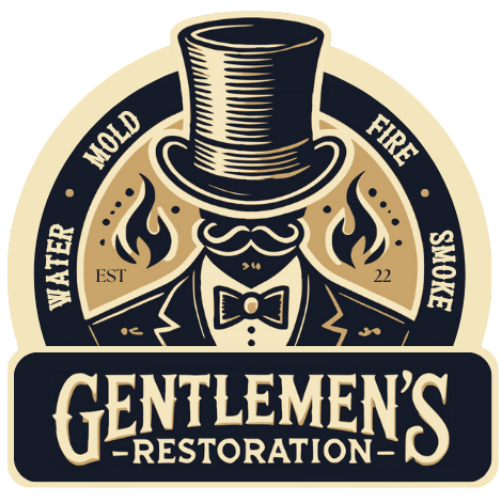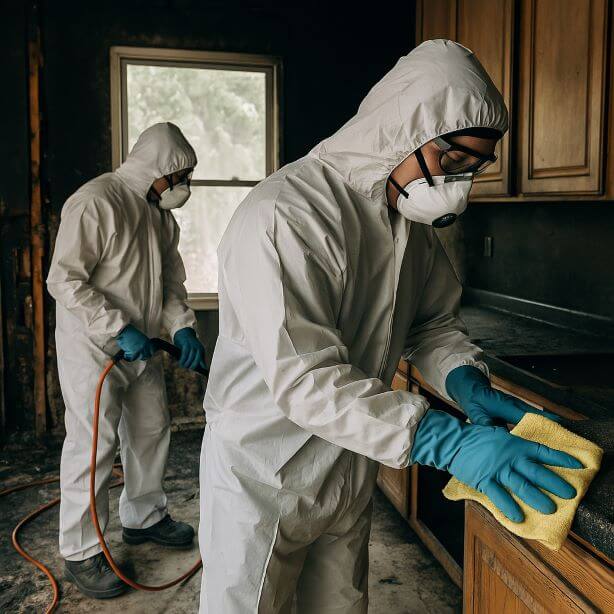Just Because the Fire’s Out Doesn’t Mean You’re Safe
After a fire, it’s natural to feel relief once the flames are gone. But what many homeowners don’t realize is that some of the biggest dangers come after the fire is out. Smoke, soot, and other invisible hazards can stick around long after the last ember cools and they can be just as dangerous, especially if you stay in the home before it’s been professionally cleaned.
At Gentlemen’s Restoration, we’ve helped homeowners and property managers across Dallas and North Texas deal with the aftermath of house fires from minor kitchen incidents to large structural losses. In this post, we’ll go over five serious health hazards that can linger after a fire and explain why professional cleanup is more than just cosmetic it’s critical to your safety.

Soot Inhalation
Soot is one of the most dangerous things left behind after a fire. It’s made up of tiny carbon particles, often mixed with chemicals from whatever burned plastic, paint, fabrics, or insulation. These particles are so small that they can be breathed deep into your lungs without you even seeing them.
Why it’s dangerous:
- Can trigger asthma and bronchitis
- Increases risk of respiratory infections
- May contain cancer-causing chemicals (like benzene or formaldehyde)
Soot doesn’t just sit on the surface it becomes airborne. Every time you walk through a damaged area, open a cabinet, or turn on a fan, you’re likely kicking those particles back into the air.
Smoke Odors = Chemical Residue
The smell of smoke after a fire isn’t just a smell it’s a sign that chemical compounds are still present in your home. These odors come from particles stuck in walls, carpets, furniture, and even your HVAC system. Some of them are harmless, but many can irritate your nose, throat, and lungs.
Symptoms of smoke inhalation can include:
- Headaches
- Dizziness
- Nausea
- Ongoing fatigue
Professional odor removal isn’t just about making your home smell fresh again it’s about removing toxic residue that your body reacts to, even when you don’t realize it.
Mold Growth from Firefighting Water
When firefighters put out a blaze, they often use hundreds of gallons of water. That water doesn’t just disappear. It soaks into floors, walls, and ceilings creating the perfect environment for mold.
Why mold grows after a fire:
- Hidden moisture in drywall or subflooring
- High humidity from steam or standing water
- Poor ventilation after the fire is sealed off
Mold can start growing in as little as 24–48 hours, especially in a high-humidity environment like north Texas. Left untreated, it can cause everything from sneezing and sinus infections to serious respiratory illness. If you’ve had water damage even if you can’t see mold yet it’s important to have it professionally checked.
Contaminated HVAC Systems
Your air conditioning and heating system can easily become a vehicle for spreading smoke and soot throughout the home. If the HVAC system was running during the fire or turned on afterward it likely pulled in smoke and particles through the vents.
These systems have:
Why mold grows after a fire:
- Filters that may now be clogged with soot
- Ducts that may be lined with toxic residue
- Fans that push these contaminants into every room
Breathing in this air can irritate lungs and keep your home smelling like smoke no matter how much you clean.
Chemical Residues on Surfaces
- Avoid re-entering the property until it's been assessed.
- Don't try to clean soot or smoke residue yourself.
- Keep pets and kids out of affected areas.
- Schedule a professional fire damage inspection ASAP.
